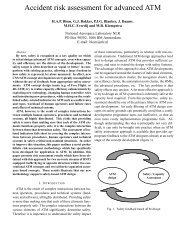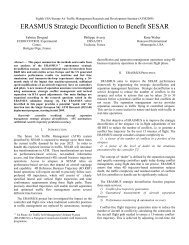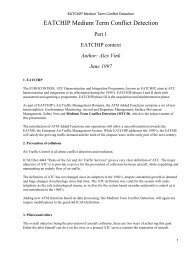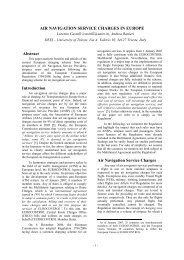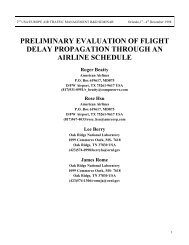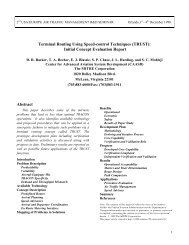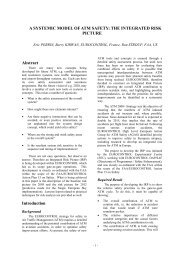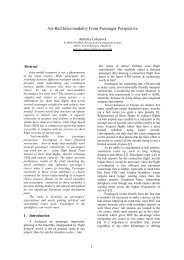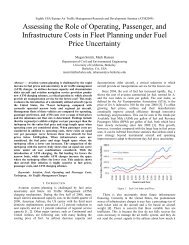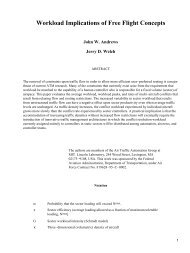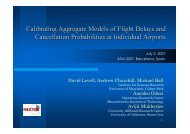a model to solve en route air traffic flow management - ATM Seminar
a model to solve en route air traffic flow management - ATM Seminar
a model to solve en route air traffic flow management - ATM Seminar
- No tags were found...
You also want an ePaper? Increase the reach of your titles
YUMPU automatically turns print PDFs into web optimized ePapers that Google loves.
The system supplying service <strong>to</strong> cus<strong>to</strong>mers consists of a finite number of elem<strong>en</strong>ts. Each elem<strong>en</strong>t can handleseveral cus<strong>to</strong>mers simultaneously but has a finite capacity which may vary sin time. Individual cus<strong>to</strong>mersdemand service from one (rarely) or more elem<strong>en</strong>ts sequ<strong>en</strong>tially. Each cus<strong>to</strong>mer has his first (optimum)choice sequ<strong>en</strong>ce, but also his alternate choice(s). The delay cost functions for each cus<strong>to</strong>mer's first andalternate choice(s) are known. Cus<strong>to</strong>mers choices are initially indep<strong>en</strong>d<strong>en</strong>t.The problem appears if <strong>to</strong>tal demand exceeds the capacity of some elem<strong>en</strong>ts at certain periods. Theassumptions are:That an overload is followed by a lower−demand−than−capacity period wh<strong>en</strong> the over<strong>flow</strong> ofdemand from the previous period can be served (completely if only temporal solution isallowed), andThat during such the overload period, each flight originally <strong>route</strong>d through a bottl<strong>en</strong>eck nodehas an alternate, longer <strong>route</strong>, passing through nodes which are not bottl<strong>en</strong>ecks.The question is:How <strong>to</strong> manage demand so as <strong>to</strong> minimize delay cost <strong>to</strong> cus<strong>to</strong>mers, or more precisely, whichcus<strong>to</strong>mers should be delayed on departure (ground hold) and for how long, going on theoriginal <strong>route</strong>s, and which ones should be giv<strong>en</strong> alternate <strong>route</strong>s (re<strong>route</strong>d) with possibleground hold (l<strong>en</strong>gth of which should also be determined), in order <strong>to</strong> yield minimum <strong>to</strong>talcost?The problem of the delay cost incurred both on the ground, in the <strong>air</strong>, and combined, will not be discussedhere. Some very important aspects of delay cost functions have be<strong>en</strong> discussed by Tosic et al. (1995). Inaddition <strong>to</strong> this, however, it should be emphasized that in the case of a spatial solution, the problem ofdeciding what a delay cost function is and how carriers perceive it, becomes ev<strong>en</strong> trickier. It will be assumedhere that these cost functions are known.3. GENERAL MODELNotation:A MODEL TO SOLVE EN ROUTE AIR TRAFFIC FLOW MANAGEMENTF − set of flights indexesFa − set of flights indexes from F that have alternative <strong>route</strong>s (Fa⊂F)A − set of <strong>route</strong> indexes, alternatives for flights from Fa, considered asadditional flightsN − <strong>to</strong>tal number of elem<strong>en</strong>tsT − <strong>to</strong>tal number of time periodsD=||dijt|| − dijt is 1 if flight i demands service at elem<strong>en</strong>t j during period t, and 0otherwise (i∈F∪A, 1, 2)Qjt − <strong>to</strong>tal capacity of elem<strong>en</strong>t j at period t ( 3, 4)ki * − maximum allowed delay of flight i (i∈F) wh<strong>en</strong> assigned <strong>to</strong> original <strong>route</strong>2



